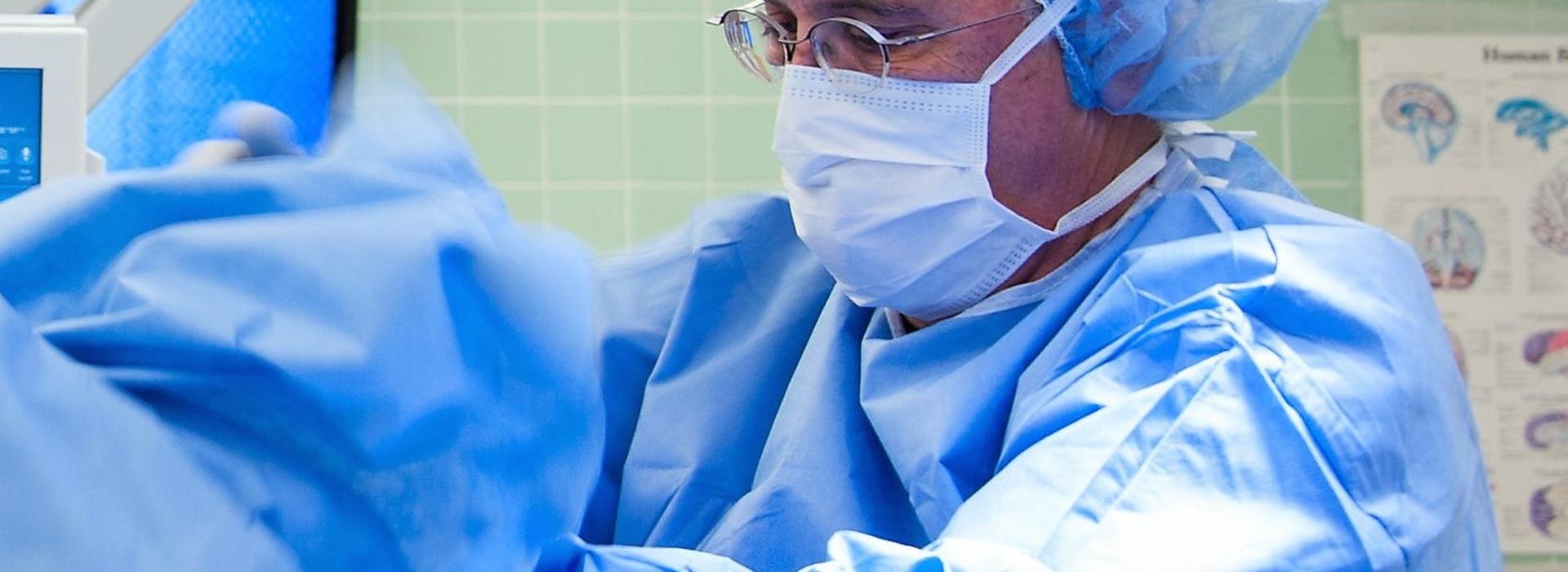
“Grateful to have my life back,” said patient after surgery for two facial pain conditions
Earlier this year, Sally*, a facial pain patient of Stephen Haines, MD, sent him a heartfelt thank-you note. In it she wrote, “Thanks to you and your colleagues, I have been pain-free, symptom-free, and have been able to have a productive healthy life.”
The week that Sally wrote the note marked the 10th anniversary of the microvascular decompression (MVD) surgery that Haines performed on her to help relieve the symptoms of what turned out to be a complex facial pain condition.
Severe, stabbing pain
“I had severe, stabbing pain in my jaw that progressed to my throat,” explained Sally. “Wind couldn’t touch my face … I couldn’t chew and it was difficult for me to swallow.” As with many facial pain sufferers, she went to her dentist first and ended up having an unnecessary root canal. A neurologist in her hometown eventually determined that Sally had a rare facial pain condition known as trigeminal neuralgia (TN).
With trigeminal neuralgia, something – usually a blood vessel – is compressing a branch of the trigeminal nerve, which starts near the top of the ear and splits into three branches toward the eye, cheek, and jaw. The nerve is responsible for sensation in the face and for motor functions such as biting and chewing. It is the most complex of the cranial nerves.
Diagnosed with another condition
But that wasn’t the only thing wrong. Sally was also diagnosed with an even rarer facial pain condition known as glossopharyngeal neuralgia, which is characterized by intermittent sharp, excruciating pain deep in the throat.
Sally confirmed the diagnosis with several specialists. When she went to an oral surgeon near where she lived, he told her about the Facial Pain Clinic at the U in Minneapolis. During an appointment at the clinic with facial pain specialist, Don Nixdorf, DDS, Sally was referred to Haines.
“The other doctors had told me I would need two surgeries, which was really disappointing,” Sally said. “Dr. Haines said he could do everything in one procedure. His demeanor also convinced me that he was my surgeon – he was calm, kind, confident, reassuring, and an understanding listener.”
Deciding to have surgery
Up to the point of meeting with Haines, Sally had been taking medications to manage her pain. Throughout the year following her diagnosis, the medication dosage had to be gradually increased. While she tolerated it well, Sally’s sodium levels were dropping, leaving her open to seizures. That reality led her to make the decision to have surgery.
“No one should have brain surgery if they can control their pain reasonably with medication and not experience side effects,” said Haines. “If medication isn’t an option, however, people should not be afraid to have surgery for these painful conditions. When done by experienced hands in experienced hospitals, it is very safe.”
Challenging case
When Haines took on Sally’s case, he knew it would be challenging. “The glossopharyngeal nerve innervates the back of the tongue and deep in the throat and it can be problematic,” he said. “Our nerves don’t read the textbooks. They can have different distributions and often overlap. It can be difficult sometimes to decide whether a patient’s facial pain is because of trigeminal neuralgia or glossopharyngeal neuralgia or both. In Sally’s case, it was clear that she had both.”
The good news for Sally was that the root cause of the glossopharyngeal neuralgia was the same as what was causing her trigeminal neuralgia – an artery was compressing the glossopharyngeal nerve. With the trigeminal neuralgia, a different artery was compressing the trigeminal nerve. “While having two nerves affected by the same problem made the operation a little more complicated, we were still able to decompress both,” said Haines.
Working through it
During the procedure, Haines and his surgical team made a larger opening than usual because they had to approach the nerves involved from slightly different directions. “And there were several blood vessels involved in the compression,” he explained. “We had to work our way through it.”
After identifying the relevant structures, Haines inserted tiny sponges between the nerves and the offending blood vessels to relieve the compression. This process typically eliminates the facial pain for most patients. That was certainly true for Sally.
Waking up pain free
“I woke up pain free,” she said. “I had some issues swallowing and went home with a feeding tube, but after completing exercises recommended by a speech therapist, the tube was removed after several days.”
Sally was so thankful to Haines and her M Health Fairview care team that she agreed to participate in a poster campaign for the 2012 Minnesota State Fair. “I was grateful to have my life back again and I wanted people to know that Dr. Haines was the doctor to go to,” she said.
Since the surgery a decade ago, Sally has experienced no facial pain. “I’m delighted that she is doing so well,” said Haines. “Two-thirds of trigeminal neuralgia patients who have this procedure are pain-free 20 years later.”
Although Haines is now retired and no longer seeing patients, if you have questions about facial pain or want to refer a patient to the Facial Pain Clinic, please feel free to call 612-624-6666.
*To protect her privacy, Sally requested that only her first name be used.



